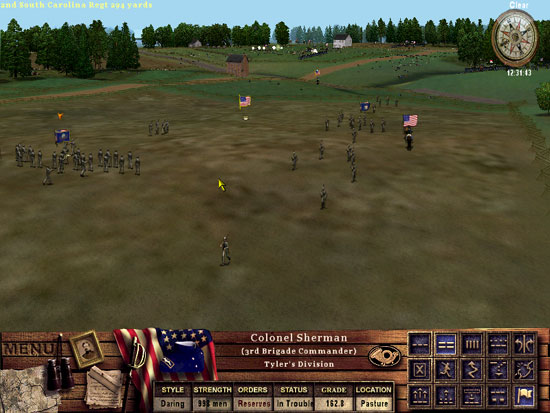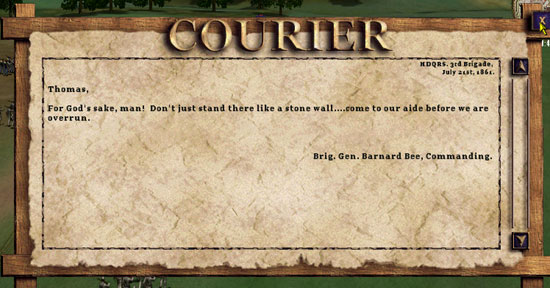|
Review
The History Channel: Bull Run
by Thomas
"WKLINK" Cofield

Introduction
After the demise of Talonsoft and
its excellent Battlefield series, there has been little for
the Civil War gamer to play. The Battlefield series really
excelled at creating a combination of tabletop enjoyment and
gritty realism that made the series a success. At times you
can still find copies of the games for sale, but hardware
and operating systems have made playing those classic games
somewhat more difficult.
About three weeks ago Doug asked one
of us to take a look at a title sent to him: Bull Run,
created by Mad Minute Games and sold under the Activision
Value brand. Activision sells their relatively low priced
but low frills games under this moniker. At around 20 bucks
retail, the games generally are rated below the higher level
that other titles in Activision's main lineup generally warrant.
In the case of this game, I would
have to say that this is a shame because Bull Run has somewhat
flown in under the radar and seems to be a much more solid
and in depth game than the ‘value’ title would suggest.
More on that in a minute.
Background on the Game
Bull Run is the common name that we
"Yankees" like to use to refer to the first major
battle of the Civil War. 1st Manassas is generally considered
the appropriate name for the first battle — if you live
south of the Mason Dixon Line. This was the first test of
the metal of both the Union Forces against the newly minted
Army of Northern Virginia.
Both sides were green and untested
at the beginning of the conflict. The Union Forces, commanded
by General Irvin McDowell, attacked a somewhat smaller, also
untested Confederate force led by Pierre G. T. Beauregard.
This, the first major battle of the Civil War, took place
in a rural Virginia road junction called Manassas Junction.
This battle occurred very close to Washington DC, so close
in fact that many of the politicians and socialites came down
from Washington to see what looked to be a very exciting battle.
Union Forces were supremely confident
in their chances. The Rebel Army, smaller and equipped in
a more ragged manner, appeared to be no match for the smart
looking Union troops. The outcome appeared to be an almost
foregone conclusion, however,
there were some serious deficiencies in the Union Army that
soon came to light.
The first was the nature of the commander,
Irvin McDowell. General McDowell was placed in charge of the
Union Forces (the term Army of the Potomac wasn’t coined
yet) after another potential commander, Robert E Lee, turned
down overall command of Union Forces. While a generally competent
officer, McDowell was not a true tactician and his limitations
would soon become apparent in the battle.
In comparison, the leadership of Confederate
forces was a ‘who’s who’ of future Confederate
leadership. Along with Beauregard, the Confederacy could claim
the great future leaders such as Jackson, Ewill and Longstreet.
Their leadership would turn the battle in the Confederacy’s
favor and turn what (the Union Forces presumed) should be
a short war into the five year battle of attrition—that
ultimately cost the South the war.
The last radical was the overconfidence
and green nature of the Union troops. While the Confederate
troops were just as inexperienced as their Union counterparts,
they were on the defensive and command and control would be
much easier than on the attack.
McDowell’s basic plan was essentially
sound, and probably would have been successful with reasonably
trained troops. His plan was to pull up the Rebel left flank
and control the field. He had the troops to do this plus still
protect his own flanks. Over thirty six thousand Union troops
crashed into the Rebel left, causing it to waiver and then
collapse.
The problem at that point was the
lack of preparedness of the Union Forces. Union Forces literally
sat out in the sun for most of the day while their artillery
softened up the enemy forces. By the time the troops reached
confederate lines they were tired and they suffered from a
serious lack of motivation. They were unable to capitalize
on the collapse of confederate forces.

The confused Confederates rallied
around the forces of then Colonel Thomas Jackson. Jackson,
an eccentric but brilliant tactician, realized the danger
posed to the confederates and held his regiment solid as other
units collapsed. His presence rallied Confederate forces and
earned him his famous nickname. Someone seeing Jackson’s
unit holding against Union forces commented that Jackson is
standing ‘like a stone wall’. The name stuck and
a legend known as "Stonewall" Jackson was born.
At this critical point Confederate
reinforcements arrived. These men attacked the tired and poorly
trained Union forces. This attack broke the back of the Federal
attack. Union soldiers began to fall back, and then run for
friendly lines. The rout was complete as the Confederate forces
quickly ran the Union Army from the field. Many of the Union
forces fell back as far as Washington DC, where they huddled
in small groups, defeated, demoralized and disorganized.
McDowell was immediately relieved
and a new Union Commander was found. It would take the leadership
of George McClelland, warts and all, to turn the Army of the
Potomac into a decent military organization.
But that is another story, and maybe
another game.
Go
To Page 2
Click here
to go to top of this page.
Copyright 2008, SimHQ.com. All Rights Reserved. Contact the webmaster.
|

